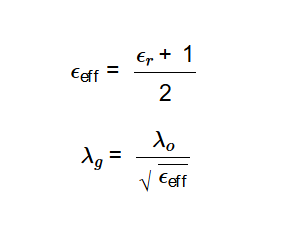1. What is a Slot Line?
Definition: A slot line is a type of planar transmission line used in microwave circuits, consisting of a narrow slot or gap in a conductive layer on a dielectric substrate. It is often used in microwave integrated circuits and antennas.
Purpose: This calculator determines the effective relative permittivity and guided wavelength of a slot line, which are critical for designing microwave circuits and ensuring proper signal propagation.
2. How Does the Calculator Work?
The calculator uses the following formulas for slot line parameters:
Effective Relative Permittivity (\( \epsilon_{\text{eff}} \)):
\[
\epsilon_{\text{eff}} = \frac{\epsilon_r + 1}{2}
\]
Guided Wavelength (\( \lambda_g \)):
\[
\lambda_g = \frac{\lambda_o}{\sqrt{\epsilon_{\text{eff}}}}
\]
Where:
- \( \epsilon_{\text{eff}} \): Effective relative permittivity (unitless)
- \( \epsilon_r \): Relative dielectric constant of the substrate (unitless)
- \( \lambda_g \): Guided wavelength (converted to m, cm, or mm)
- \( \lambda_o \): Free-space wavelength (\( \lambda_o = \frac{c}{f} \), in m)
- \( c \): Speed of light (\( 3 \times 10^8 \, \text{m/s} \))
- \( f \): Frequency (converted to Hz from Hz, kHz, MHz, or GHz)
Steps:
- Enter the relative dielectric constant \( \epsilon_r \) of the substrate.
- Enter the frequency \( f \) and select its unit (Hz, kHz, MHz, GHz).
- Click "Calculate" to compute the effective relative permittivity and guided wavelength.
- Select the output unit for guided wavelength (m, cm, mm) in the result section.
- Results are displayed with 4 decimal places, or in scientific notation if less than 0.001.
3. Importance of Slot Line Calculations
Slot line calculations are essential for:
- Microwave Circuit Design: Ensures proper impedance matching and signal propagation in microwave integrated circuits.
- Antenna Design: Determines the guided wavelength for designing slot antennas and other RF components.
- Signal Integrity: Helps optimize the performance of high-frequency circuits by accounting for the effective permittivity of the substrate.
4. Using the Calculator
Examples:
- Example 1: FR4 Substrate at 1 GHz (Guided Wavelength in mm)
- \( \epsilon_r = 4.5 \), \( f = 1 \, \text{GHz} = 1 \times 10^9 \, \text{Hz} \)
- \( \epsilon_{\text{eff}} = \frac{4.5 + 1}{2} = 2.7500 \)
- \( \lambda_o = \frac{3 \times 10^8}{1 \times 10^9} = 0.3 \, \text{m} \)
- \( \lambda_g = \frac{0.3}{\sqrt{2.75}} \approx 0.1809 \, \text{m} \)
- In mm: \( 0.1809 \times 1000 = 180.9061 \)
- Example 2: Alumina Substrate at 10 GHz (Guided Wavelength in mm)
- \( \epsilon_r = 9.8 \), \( f = 10 \, \text{GHz} = 10 \times 10^9 \, \text{Hz} \)
- \( \epsilon_{\text{eff}} = \frac{9.8 + 1}{2} = 5.4000 \)
- \( \lambda_o = \frac{3 \times 10^8}{10 \times 10^9} = 0.03 \, \text{m} \)
- \( \lambda_g = \frac{0.03}{\sqrt{5.4}} \approx 0.0129 \, \text{m} \)
- In mm: \( 0.0129 \times 1000 = 12.9118 \)
- Example 3: Air Substrate at 100 MHz (Guided Wavelength in cm)
- \( \epsilon_r = 1 \), \( f = 100 \, \text{MHz} = 100 \times 10^6 \, \text{Hz} \)
- \( \epsilon_{\text{eff}} = \frac{1 + 1}{2} = 1.0000 \)
- \( \lambda_o = \frac{3 \times 10^8}{100 \times 10^6} = 3 \, \text{m} \)
- \( \lambda_g = \frac{3}{\sqrt{1}} = 3.0000 \, \text{m} \)
- In cm: \( 3 \times 100 = 300.0000 \)
5. Frequently Asked Questions (FAQ)
Q: What is a slot line used for?
A: A slot line is used in microwave circuits and antennas, particularly in microwave integrated circuits (MICs) and monolithic microwave integrated circuits (MMICs), for applications like filters, couplers, and antennas.
Q: Why is the effective relative permittivity important?
A: The effective relative permittivity (\(\epsilon_{\text{eff}}\)) accounts for the dielectric properties of the substrate and air, affecting the propagation characteristics of the slot line, such as the guided wavelength.
Q: How does unit conversion work in the calculator?
A: The calculator converts frequency to Hz (e.g., 1 GHz = \( 10^9 \) Hz) and guided wavelength to the selected unit (e.g., 1 m = 100 cm, 1 m = 1000 mm).
 Home
Home
 Back
Back
